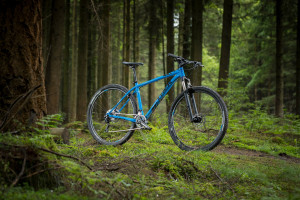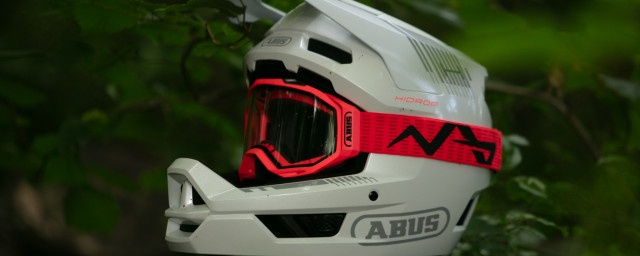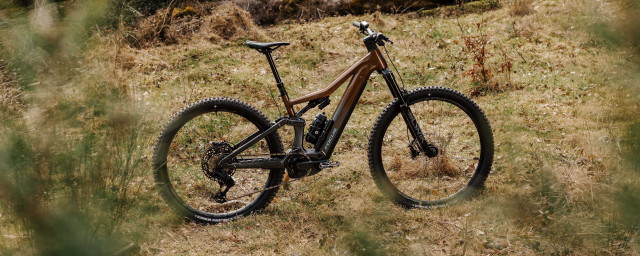Decathlon's in-house bike brand is Rockrider and this RACE 900S is a full-suspension, cross-country bike with specifications that will have you double-checking the price. A carbon frame, wireless shifting and specs that wouldn't be out of place on a bike twice the price. But, while it looks amazing on paper, can it deliver the ride of top options in the best mountain bike space?
Rockrider RACE 900S mountain bike - Technical details
The bike is classified as a cross-country bike and it is intended for racing in both XCO (cross-country Olympic) and XCM (cross-country marathon). Sponsored riders have already given the bike some pedigree, including top-ten results in the UCI MTB World Cup events and a win at Transvesubiene. As a previous Transvesubiene rider, I can tell you that it's a crazy point-to-point race in the south of France, tackling super technical descents (I had to walk several) and challenging climbs (I had to walk some of these, too), pushing the boundaries of what you'd classify as XC and, in reality, it's more of a blend of enduro and cross-country.
The frame is constructed of carbon fibre and has 120mm of travel with a linkage-driven single-pivot design. The brake and dropper seat post cables are routed internally and, while the model we have has wireless shifting, for cabled versions the rear routing would be external, with small clamps placed on the underside of the downtube. The cable ports at the front are quite small but the area near the bottom bracket offers greater access. However, it exits pretty close to the crank arms. While not everyone would agree, I am glad to see there is no internal headset routing. It does seem many bikes are heading towards an internal design but there are other ways to clean up your handlebars.
The chainstays in the rear triangle are very wide, while the seatstays have a flattened section, allowing the frame to flex slightly and eliminating the need for extra pivots. There is a press-fit BB92 bottom bracket shell, which may be a small contributor in keeping the price low, a single bottle cage mount, a 31.6mm seat tube offering plenty of dropper seatpost options and the rear derailleur is attached by an SRAM UDH derailleur hanger.
Rockrider claims a frameset weight of 1,980g, which does not include the Rockshox SIDLuxe Select shock. The overall weight of our test bike with tubeless tyres and no pedals is 12.2kg (26.9 lbs), showing that while it is targeted at racers, it is not a flyweight. The bike comes with a dual-lockout system that engages both the front and rear suspensions at the same time using the RockShox TwistLoc system.
Rockrider RACE 900S mountain bike - Componentry
The version we have on test has some components that will be different to the UK market version. Mavic Crossmax wheels will be fitted in place of the Reynolds carbon wheels and a RockShox Reba in place of the SID seen here.
Other key parts, including the wireless SRAM GX AXS drivetrain, dropper seatpost, brakes and finishing kit remain unchanged.
Putting the GX AXS drivetrain onto a bike at this price point, at full retail price, is almost unheard of for the current bikes on the market and a very nice touch at that.
The aluminium Mavic Crossmax wheels that come on the UK spec have a narrower rim internal width of 25mm as opposed to 30mm front and 28mm rear on the Reynolds wheels.
The SID benefits from large 35mm stanchions and impressive performance, holding up well through mid-travel, with ample stiffness but still retaining speed for faster singletrack. Because there are several differences between the two forks, the Reba is likely to reduce performance in some ways, although hopefully not significantly.
The dropper post that has been fitted is unbranded, and while it had a little more wiggle than the top brand options, it still operated well. The cable pull was smooth and it returned quickly.
The stem and handlebar are in-house items made from aluminium and the flat top stem looks great while also keeping the front end lower. The stem length varies with size from 60mm on the S to 90mm on the XL. The 720mm bar width was enough for me, however, many bikes will come with much wider bars. A wider bar would be better, as they are easy to cut down if needed.
Rockrider RACE 900S mountain bike - Performance
The substantial carbon sections in the rear triangle match the wide carbon sections in the headtube, which is one of the first things you notice when sitting on the bike. The stem has a negative 7-degree angle and a flat top for a race-like look. With a 120mm fork and 105mm headtube length, it has a higher front end than some other race-oriented XC bikes, so the position isn't so low that it reduces confidence on steeper downhills. Some riders may prefer a lower riding position and as seen with some of the elite racers using the Rockrider RACE 900S, a 100mm fork can be fitted and there are several stems available with a steeper negative angle.
I found the riding position to be comfortable and the dual lockout, activated by the grip-shift style Twistloc, works well for both climbs and flats. The one drawback for me is the grips, which are narrow and firm – I assume this was installed to match the Twistloc's diameter. It is possible to change the grips and several pro riders who use the 900S have done so but it will not have the same smooth aesthetic.
With a dual-lockout and cable-actuated dropper, the wireless AXS shifter eliminates one cable but there are still a few on display. External cabling makes it easier to work on and replace cables as needed.
The 2.3in Hutchinson Kraken Racing Lab tyres offer good width and work well in a range of conditions and the bike rolls pretty well. They don't match the best mountain bike tyres for cross-country when it comes to low rolling resistance and there are trade-offs on some surfaces.
They do well in the wet as long as the mud isn't too deep. The carcass varies on both ends, with the back Hardskin shell being firmer and more puncture-resistant. The Krakens are suitable as a year-round riding tyre, but if you intend to race the bike, a more supple, faster rolling tyre would be a sensible upgrade.
The front end, when matched with the SID fork was great and was simple to set up and adjust. It holds up nicely during the mid-stroke and absorbs the blows well on heavier hits. If the Reba can provide similar results, it will create a confident bike to ride.
The rear suspension setup with SIDLuxe Select + shock was more difficult to set up. The 2.5mm bolt head was in an awkward place for setting the rebound damping making adjustments more difficult.
I had the bike set up with the recommended sag but I was blowing through full travel on every ride, even with no big jumps or impacts. Increasing the pressure will likely reduce small bump sensitivity but you could try volume spacers to increase the progression in the stroke. This is something we've seen on other Rockrider bikes, such as the AM 100S.
The bike's overall geometry is not as progressive as some more recent cross-country bikes, such as the Berria Bravo we recently tested. The RACE 900S has a 68-degree head angle across all sizes and the medium has a 420mm reach, which is quite short when compared to other brands' medium-sized bikes. The seat tube angle is 73 degrees and I ran the saddle at the farthest forward setting to help shift the weight forward when climbing. It did climb well, especially on steeper, more technical climbs.
Riding downhill on typical trail centre terrain, the carbon frame and wide tyres allow you to confidently push downhill and the Reynolds carbon wheels will help with this. It would be interesting to see how the Mavic Crossmax wheels compare, though an alloy rim with a 25mm rim ID paired with a 2.3in tyre is unlikely to give as much support on the corners.
Specific sizing changes are limited and the head tube and seat tube angles, as well as rake and BB drop are the same for all sizes. Crank length ranges from 170mm on the Small to 175mm on the other sizes. The stem length increases from 60mm on the small to 90mm on the XL.
My calf rubbing on the seat stay was something I wasn't expecting to experience and it's not something I've had on any other bike. The flattened seat stay widens where the leg passes during the pedal stroke. I don't ride with narrow Q-factor pedals or inward-facing cleats, so I assume other riders may experience a similar problem. It is more of an annoyance than a performance issue but it can be frustrating nonetheless.
The SRAM GX AXS shifting was great, as you would hope and expect. It provides clean, accurate and quick shifting, even under power. One big difference between a cable derailleur and a wireless groupset is the effectiveness of shifting when dropping down to the 10T sprocket. Without any form of cable friction, it just works. Micro-adjustments on the fly while riding are possible and I like the rocker shifter, with the double button location for upshifts. You can also completely customise the button setup, should you wish to swap things around.
Decathlon suggests that the RACE 900S is suitable for cross-country marathon racing and the geometry should make it this way, however, having only a single bottle cage within the front triangle won't work for a lot of marathon racers.
Rockrider RACE 900S mountain bike - Value and verdict
The SRAM AXS drivetrain will appeal to many interested buyers and there aren't many other options that can compete on price – with some costing over double the price of the Rockrider. The Specialized Epic EVO Expert costs £6,250, while the Trek Top Fuel 8 costs £4,500, the Cannondale Scalpel Carbon SE1 is £5,500 and the Canyon LUX Trail is priced at £5,500.
There is more to a bike than the groupset though and if you are looking for a different build, the same models will be fitted with a mix of mechanical Shimano SLX, XT or SRAM NX drivetrain components and alloy wheels.
Even if the price element is removed, the Rockrider RACE 900S has a build quality that is competitive with other rival bikes. I can feel a little compromised at times, attempting to meet the demands of both racers and more general riders. For racers, the weight isn't competitive and several aspects might be improved to boost performance. It also lacks an extra bottle cage. It doesn’t have the most extreme geometry, even for a cross-country bike but it still works well in both technical climbing and descending situations.
Riders sponsored by Rockrider have been seen riding a revamped version, which is expected to be released in early 2024. No pricing or geometry specifics have been revealed, however, it will have two bottle cages and a revised shape to the seat stay, which could stop the problems I experienced. Is it worth the wait and will it be more expensive? At this point, we don't know but what we do know is that the RACE 900S provides value that surpasses all other options, and while there are a few areas that may not suit everyone, most do not have a substantial impact on performance.
Even after adding volume spacers to the rear shock, a thread-together press-fit bottom bracket, and a pair of carbon wheels, it will still be cheaper than most rivals. Although pushed as a cross-country race bike, I believe the RACE 900S appeals more to general riders and those looking for a fast-riding cross-country bike.
























Add comment